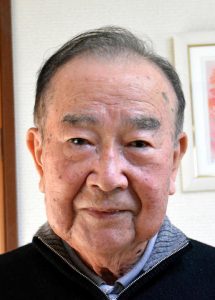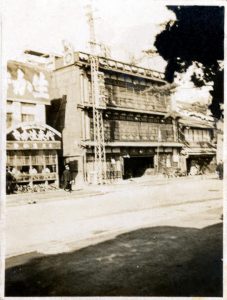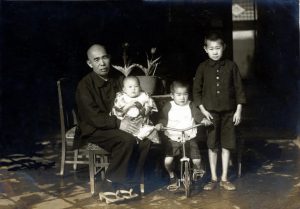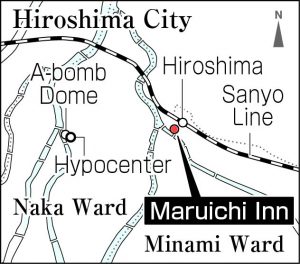Striving to fill voids in Hiroshima—Recreating cityscapes: “Maruichi Inn,” in front of Hiroshima Station, as seen in family’s keepsake photos
Jan. 30, 2023
Photos showing south side of train station donated to Peace Memorial Museum
by Kyosuke Mizukawa, Senior Staff Writer
Two photographs of “Maruichi Ryokan” (in English, ‘Maruichi Inn’) before the atomic bombing have been donated to the Hiroshima Peace Memorial Museum, located in the city’s centrally located Naka Ward, by Kanji Okita, 86, a resident of Minami Ward. The inn, located on the south side of the JR Hiroshima Station, an area that is now the heart of an ongoing redevelopment project, was once the home of the Okita family. Five members of Mr. Okita’s family were killed in the U.S. military’s atomic bombing, putting the inn out of business. The photos he treasured in memory of his family will be used by the museum to communicate the appearance at the time of the area, known as Hiroshima’s gateway on land, and the damage wrought by the atomic bombing.
Maruichi Inn, founded in 1918 on the corner where the present-day Fukuya Ekimae Department Store stands, was managed by Mr. Okita’s father, Isotaro. The inn was a three-story wooden building that was deep from front to rear, with a courtyard by the guest rooms on the first floor. It was one of several well-known inns located near the train station.
Mr. Okita was born the seventh of eight children. He lived with his family in the living quarters on the first floor of the inn until he was eight years old. “My friends often came to play with me. There was a ten-mat tatami room on the second floor in which futons were stored, and we would play hide-and-seek there,” he said, describing some of his many memories from those days.
In the spring of 1945, just before he was about to advance to the third grade of a national school, he was evacuated for the sake of his safety to a relative’s home in Okayama Prefecture by his mother, Tsuchiyo, who stayed with him for the first two days. One morning, he awoke to find her gone.
“I heard she had left the relative’s home while I was asleep because she wanted to avoid seeing me running after her crying. It must have been with great reluctance that she left me behind.” Mr. Okita should have been able to reunite and live with his family after the war, but that proved to be impossible.
On August 6, the inn, located about 1.8 kilometers from the hypocenter, was destroyed and burned to the ground. Five family members were killed in the atomic bombing: Isotaro, then 54, and Tsuchiyo, 48, who were in the inn at the time, the third oldest sister, Mieko, 21, older brother, Toshio, 15, and younger brother, Katsukuni, six years old at the time. Their remains were later found in the burned ruins of the inn.
After the war, with no building or owner, Maruichi Inn was unable to recover. Mr. Okita returned to Hiroshima City in the spring of 1946, and lived throughout the difficult postwar period with his fourth oldest sister in a shack near the site of the inn.
One of the photos donated to the museum shows the exterior of the inn with a sign that reads “Maruichi,” taken around 1943, and the other photo is of the front entranceway to the inn, taken in 1940. “They remind me of my happy childhood,” he said. “I hope people can understand through the photographs even a little of how the war and the atomic bombing completely transformed our lives.”
The photo of the inn’s exterior also shows a sign “Raw Oysters” on the building next to the inn, indicating active marketing of the local specialty that took place in front of the station since that time. Mr. Okita’s father, who died in the bombing, appears in the photo of the inn’s entranceway. A spokesperson for the museum said, “The photos are valuable materials by which people can learn about the area in front of Hiroshima Station before the atomic bombing and about a family living there that later became A-bombing victims. We hope to introduce the photos in our New Arrivals Exhibit.”
(Originally published on January 30, 2023)











